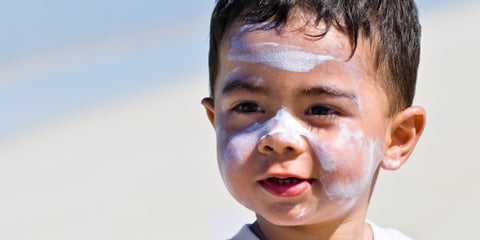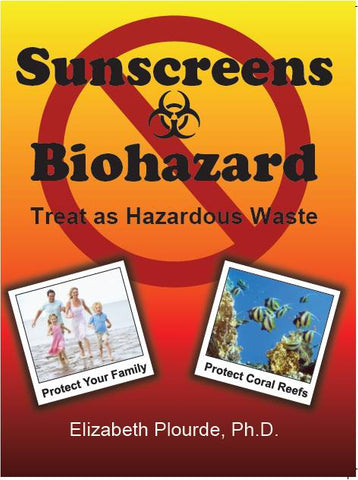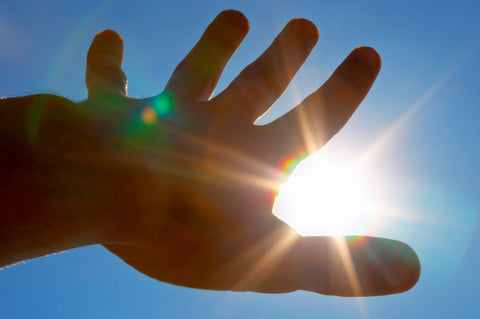
Sunscreen Controversy II- Sun or Sunscreen Causes Skin Cancer?
The goal of AMG newsletters is to get better and better at reading and understanding the labels of lotions and potions we put ON Our bodies. Let's live and learn. We all know it is important to scrutinize our food labels so we can make healthy choices. We also need to make healthy cosmetic choices. I am beginning to believe the wrong cosmetics may be worse for our health than bad foods. You are hearing this out of a nutritionist's mouth. Obviously I spent years making dietary changes and supplement recommendations to thousands of people for their own well-being. Think about the fact that the skin has no liver. In other words, it has no filtering system. What gets absorbed through the skin goes right into the blood.
This newsletter is Part II of “The Sunscreen Controversy”. Sunscreen is man-made. The sun is God-made. Without the sun there would be no life on earth, as we know it. Let's take a minute to look at documented science. Researchers have studied the effects of UVA and UVB on human skin. The evidence is conclusive that radiation from the sun, ultraviolet A and B, makes unprotected skin less healthy - ability to make collagen is impeded, skin aging and sunburn can occur.
Women who avoid sunbathing during the summer are twice as likely to die as those who sunbathe every day.
A groundbreaking study was recently conducted by researchers at the Karolinska Institute in Sweden. You may be shocked by their findings because it is contrary to what experts in the U.S. have been telling us for years. They found that women who avoid sunbathing during the summer are twice as likely to die as those who sunbathe every day.
This epidemiological study followed 30,000 women for over 20 years and “showed that mortality was about double in women who avoided sun exposure compared to the highest exposure group.”
"The conventional dogma, which advises avoiding the sun at all costs and slathering on sunscreen to minimize sun exposure, is doing more harm than actual good".
The researchers go on to say “It is important to allow your skin to be exposed to sun for adequate vitamin D production, the absolute best way to obtain vitamin D”, as was discussed in AMG’s last newsletter. Sun block definitely blocks this.
Interestingly, and again, a bit of a shocker, the link between melanoma and sun exposure (dermatology’s dogma) is unproven. There’s no conclusive evidence that sunburns lead to cancer. There is no real proof that sunscreens protect against melanoma. There’s no proof that increased exposure to the sun increases the risk of melanoma, the deadliest form of skin cancer.
A 2000 Swedish study concluded that higher rates of melanoma occurred in those who used sunscreen versus those who did not.
The Swedes were the first to determine that amalgam (mercury mixed with other metals) fillings for cavities were dangerous and should never be placed in pregnant women because of possible danger to the fetus. Is it possible that the chemicals in sunscreen are increasing melanoma and other skin cancers? Stay tuned for next newsletter on the topic of dangers to the liquid ecosystem (ocean) from chemical sunscreens.
People are most afraid of melanoma, the most deadly form of skin cancer. I see ads in magazines with famous faces making us feel guilty if we don't use sun block every day to prevent deadly melanoma. Scare tactic? Do we really understand the causes, which are never straightforward or simple?
Why do people who get organ transplants get melanoma? They aren't in the sun while in the hospital. Do they need an organ transplant because of past sunburns? Is it because their immune systems are weak because of the prescribed immune suppression drugs? That's what medical sites say. Immunosuppressive medications are essential to transplant patients to prevent graft rejection and optimize graft survival. I would expect someone in the hospital with a weak immune system to get a cold or flu, or bronchitis, or pneumonia. Melanoma? Why??
UCSFHEALTH.org says:
"Organ transplant patients are at a higher risk — up to a 100-fold higher — for developing skin cancer compared to the general population. Transplant patients tend to develop a skin cancer called squamous cell carcinoma and Kaposi sarcoma. Many patients also develop a skin cancer called basal cell carcinoma and even deadly melanoma.”
The exact mechanism that leads immunosuppressive medications to promote tumor growth is being studied. Some research suggests that the duration, intensity and type of immunosuppressant may be related to the development of skin cancer.
Vitamin D deficiency is on the rise in recent years, correlating with the increase use of sun blocks. Skin cancer is on the rise as well. Vitamin D deficiency is known to contribute to an increase in death from the top diseases we are worried about, namely heart disease and cancer; every type of cancer including skin cancer.
Autoimmune disorders occur when the body’s immune system is tricked into producing antibodies that attack its own tissues. Vitamin D helps autoimmune disorders by regulating T cells in the immune system. This makes the body more tolerant of itself and less likely to mount autoimmune responses.
Vitamin D deficiency has been linked to many autoimmune diseases, including type 1 diabetes, systemic lupus erythematosus, multiple sclerosis, and Crohn’s disease, as research shows a higher prevalence of these diseases in those who are deficient in vitamin D. The severity of Crohn’s disease has been linked to the lowest vitamin D levels. As new research develops, the list continues to grow.
- Some 600,000 cases of breast and colorectal cancers could be prevented each year if vitamin D levels among populations worldwide were increased, according to previous research by Dr. Garland and colleagues.
- Optimizing your vitamin D levels could help you to prevent at least 16 different types of cancer including pancreatic, lung, ovarian, prostate, and skin cancers.
- A large-scale, randomized, placebo-controlled study on vitamin D and cancer showed that vitamin D can cut overall cancer risk by as much as 60 percent. This was such groundbreaking news that the Canadian Cancer Society has actually begun endorsing the vitamin as a cancer-prevention therapy.
- Light-skinned women who had high amounts of long-term sun exposure had half the risk of developing advanced breast cancer (cancer that spreads beyond your breast) as women with lower amounts of regular sun exposure, according to a study in the American Journal of Epidemiology.
- A study by Dr. William Grant, Ph.D., internationally recognized research scientist and vitamin D expert, found that about 30 percent of cancer deaths -- which amounts to 2 million worldwide and 200,000 in the United States -- could be prevented each year with higher levels of vitamin D.

Take home tip:
Is tanning bad for you?

Melanin is produced in the skin to allow tanning and its main purpose is to prevent burning and protect the skin. So why is tanning so badly? Should we all walk around stark white or should we make our skin tougher? The reason for so many sun goddesses is because we tend to look better tan. A tan brings out our eye color, our teeth look whiter, we have more energy, and we feel happier. So, we need to forego all of this and be as white as possible while using our white sun block with toxic chemicals known to mess up our hormones and contribute to cancer? This is simply my opinion, but I have learned not to believe everything authorities try to teach us. How much is propaganda? How much is about putting more money into an influential company's pocket? How did Monsanto get GMO passed so fast?

EWG, the well-respected Environmental working group, analysts recently sifted through more than 1,700 sun protection products this year and found that 80 percent of the products they reviewed contain extremely harmful ingredients.
This is a list of ingredients commonly used in sunscreens that have been proven to contribute to DNA damage which can lead to cancer:
1. Oxybenzone- more toxic when exposed to sun (photocarcinogen)
2. Octocrylene- mutations and cell death from cell signaling disruption
3. Octinoxate- used in 90% of sunscreens. Extremely toxic in sunlight
4. Homosalate- messes up hormones (mimics estrogen),
toxic to organs, more toxic in sun.
5. Dioxybenzone- definitely penetrates and goes into bloodstream, cancer-causing, contributes to wrinkles, aging, and collagen breakdown. (Aren’t we told to use sun block to help prevent all of this?)
6. Phenylbenzimidazole- DNA damage/cancer, mimics estrogen
Don't use sunblock SPRAY unless you want these chemicals in your lungs!!!!
So, what's the solution? Why do we have to make synthetic skin protection chemicals in a laboratory? Why can't we mimic what nature does?
How should a sunscreen work?
What if your sun lotion allowed you to slowly tan, by supporting minimal melanin production, blocked burning sun rays, supported the skin’s natural vitamin D production, stopped damage to skin cells and to top it off, while increasing collagen production? After a thorough study of how plants protect themselves from frequent sun exposure (Some plants make their own SPF!) and reading published research studies on sun damage and skin cancer, I created a sun formula that can do just this, all of this. Some plants also have anti-aging hormones, called cytokinins, that slow their aging process. We should mimic nature's sun secrets. AMG's new sun protect and repair formula is called "Nature's Sun Secret". This patent-pending formula has the potential to completely change “sun protection” as we know it.
Now let's analyze a sunscreen formula on the market to help you look for bad ingredients.
The label will separate active ingredients (known UVA/UVB blockers) from inactive ingredients. The word inactive does not mean they are not harmful. Take a look. This product is made by Bayer:
- Active Ingredients: Avobenzone 3%, homosalate 13%, octisalate 5%, octocrylene 7%, oxybenzone 4%.Inactive Ingredients: Water, sorbitol, aluminum starch octenylsuccinate, VP/eicosene copolymer, stearic acid, triethanolamine, sorbitan isostearate, benzyl alcohol, dimethicone, tocopherol (vitamin E), polyglyceryl-3 ...
We put aluminum, toxic metal on the periodic table, up there with mercury, on our armpits when we use deodorant that is ALSO an antiperspirant. Does it sound like a good idea to rub aluminum onto your skin multiple times while in the sun in order to stop you and your children from burning knowing that it absorbs into your blood stream?
Last newsletter we covered the dangers of avobenzone, octisalate and octocrylene. So today, we will focus on the following:
-Homosalate: hormone disruptor (may increase breast cancer risk)
-Aluminum: toxic heavy metal, hormone disruptor, may contribute to Alzheimers and cancer (Aluminum hydroxide is an ingredient in BABY Bee’s Sun block, ingredients listed below). I WOULD NEVER PUT THE TOXIC METAL ALUMINUM ON MY BABY. It is also found in majority of anti-perspirants.
-TEA( TriEthanolAmine): carcinogenic by producing nitrosamines
Are we aiming to be "white as a ghost" and "sick as a dog"? Shouldn't we drink our ethanol, otherwise known as alcohol, not rub it on our skin?

BABY Bee’s
- Active Ingredients: Titanium Dioxide (11.4%), Zinc Oxide (4.9%). Inactive Ingredients: helianthus annuus (sunflower) seed oil, helianthus annuus (sunflower) seed wax, persea gratissima (avocado) oil, crambe abyssinica seed oil, cannabis sativa seed oil, euphorbia cerifera (candelilla) wax, stearic acid, aluminum hydroxide, jojoba esters, tocopherol, glycine soja (soybean) oil.
Let’s also remember that many ingredients in SUNSCREENS sold in the U.S., approved by the FDA, are CARCINOGENIC. Zinc oxide and titanium dioxide, which we would assume are safer, NANOparticles, are absorbed deep into DNA and are UNSAFE. Chemists do this so these won’t leave white residue, unabsorbed, sunscreen ON the skin.Thyroid problems are on the rise such as Hashimotos and Hypothyroidism, as well as ADHD and AUTISM. Meanwhile, hormone disruptors found in sunscreens and cosmetics have a very negative effect on thyroid function and brain development.
Remember, you are what you absorb! Read all cosmetic labels carefully. Recommend this newsletter to a friend.
RECOMMENDED READING:
SUNSCREENS BIOHAZARD – Treat as Hazardous Wasteby Elizabeth Plourde, Ph.D.

“Just because something works, doesn’t mean it’s the best way to do it.”
Famous quote by my friend, author, lecturer and nutritionist: Robert Crayhon.


